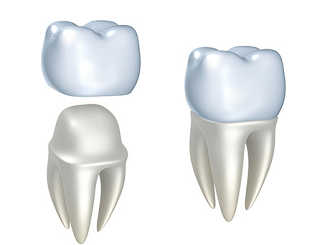
Dental Caps and Dental Crowns
A cap is the same thing as a crown. A tooth requires a crown when strength is needed, or when there is too much tooth missing for a filling, the restoration wraps around the outside of the whole tooth.
Crowns and Caps - Repairing and Protecting your Teeth
There are several different ways to protect a tooth. The usual way is to completely cover the tooth with material, either metal (gold), porcelain or a combination of the two
A bridge is two or more capped teeth connected together with one or more false teeth in between the capped teeth. Some people like to call their removable appliances bridges but they are really partial dentures; (Dentists call both types of prostheses partial dentures: fixed partial denture or removable partial denture).
Putting in Crowns and Caps
We remove a significant portion of the tooth to make room for the material the crown is made of. If we simply added material, the gum doesn’t know that the crown isn’t tartar or calculus on the tooth and will recede or move away from the crown and this could create a gum or periodontal disease situation. Since the tooth has been reduced and the enamel covering is removed, the tooth becomes sensitive unless we place a temporary crown, usually made of an acrylic or composite material. The temporary crown also maintains the position of the tooth while the crown is being made in our onsite lab. A temporary crown can be worn from as little as two weeks up to three months.
Materials used in Crowns and Caps
Crowns can be made of metals such as gold or palladium or a combination of several metals. Porcelain can be baked onto the metal, much like a bathtub, to make the crown look like a natural tooth. There are all ceramic materials used today with dentists claiming that the teeth have no metal. The teeth look all white. The truth is, if the crown is made from zirconium, although it looks white, zirconium is actually a metal (remember your periodic table of the elements from junior high school science class?). There is a big push by laboratories these days to make milled crowns. The fit is good, they look white, and the research claims they have very high strength. I have used many of these types of crowns and they have a higher failure rate than the old fashioned porcelain fused to metal types. In addition, more tooth structure has to be removed for these crowns. Some dentists claim that these crowns are more esthetic because the natural tooth color bleeds through the ceramic material, truth is, most people don’t want their old brown color back – they want nice white teeth!

